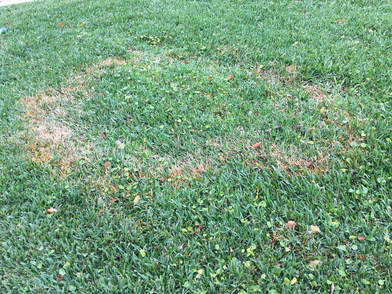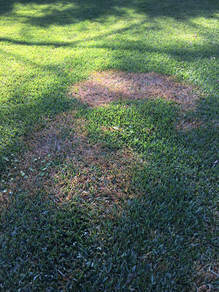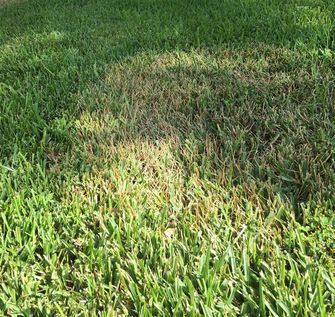Large Patch Fungus
 Large Patch Fungus In St. Augustinegrass Lawn
Large Patch Fungus In St. Augustinegrass Lawn
Large Patch Fungus (Rhizoctonia solani) is a cool-season disease of turfgrass. Until recently, this disease was known as Brown Patch Fungus.
In Central Florida, St. Augustinegrass, Zoysiagrass, and Bermudagrass are particularly susceptible. While disease symptoms are most prevalent in the fall through early spring, the disease may infect grass any time of the year, provided environmental conditions are conducive for infection.
In Central Florida, St. Augustinegrass, Zoysiagrass, and Bermudagrass are particularly susceptible. While disease symptoms are most prevalent in the fall through early spring, the disease may infect grass any time of the year, provided environmental conditions are conducive for infection.
Infected grass areas exhibit browning with yellowish margins. Often - not always - there is a doughnut pattern as grass recovers in the center while the diseased margins progress outward. The grass blades slough off where they attach to the stems. The fungal pathogen resides in the soil and often reappears in the same areas every season once weather conditions favor its development.

Because there is such a drastic and noticeable effect in the grass, this disease appears to be more serious than it is. In most (not all) cases, the effects of this disease are mainly cosmetic, particularly if the grass is otherwise healthy. The unsightly diseased grass is temporary and the grass typically recovers without completely dying back. However, the disease can recur many times and the appearance of the lawn may not improve until soil temperatures are consistently warmer - typically in later spring and summer months.
Once Large Patch Fungus appears in your lawn, we treat with fungicides to help slow its progression. Fugicide applications are not curative though, which is why the fungus typically re-infects the grass.
Environmental and cultural conditions that promote the incidence and spread of Large Patch Fungus include soil temperatures in the 70°F's or less along with any of the following:
- Moist soil and canopy (grass stems and blades)
- Too frequent rain or supplemental irrigation
- Excessive thatch
- Mowing the lawn while wet
- Traffic (mowing, walking, etc.) through diseased areas
- Excessive nitrogen fertilization
- Application of certain selective herbicides

Very often, homeowners mistake the rapid browining to intermittent lack of water, and proceed to water and fertilize more. This, in turn, promotes the virulence and spread of the disease.
Many fungicide products are effective in mitigating Large Patch Fungus. Any application of fungicide labeled for management of Large Patch disease will be more effective if the following cultural percautionary steps are taken to mitigate the disease:
- Limit watering to only when the lawn is showing stress due to lack of water
- When watering, ensure the application of 3/4 to 1 inch of water per cycle - avoid frequent, short-duration, watering - click here for more information
- Mow the lawn at the appropriate mowing height - click here for more information
- Mow the lawn while the canopy (stems and leaves) are not moist - do not mow in early morning or following rainfall or irrigation
- Mow over diseased areas last as the mower will spread the disease
Treatments for Large Patch Fungus are included with your Lawn Care service. We offer a Large Patch Fungus mitigation program that may reduce the severity of the disease. We mail out offer letters for the program in late summer.
Many of our customers take advantage of our Large Patch Mitigation Program. Please consider this program if Large Patch disease causes severe discoloration to your lawn, or if you simply want to reduce the stress that this fungus causes to your turf. The additional applications of systemic fungicides will target Large Patch fungus that already began infecting the grass as well as protect the grass when infection potential is the greatest.
If you suspect Large Patch Fungus in your lawn, please contact us for an inspection, diagnosis, and treatment proposal.